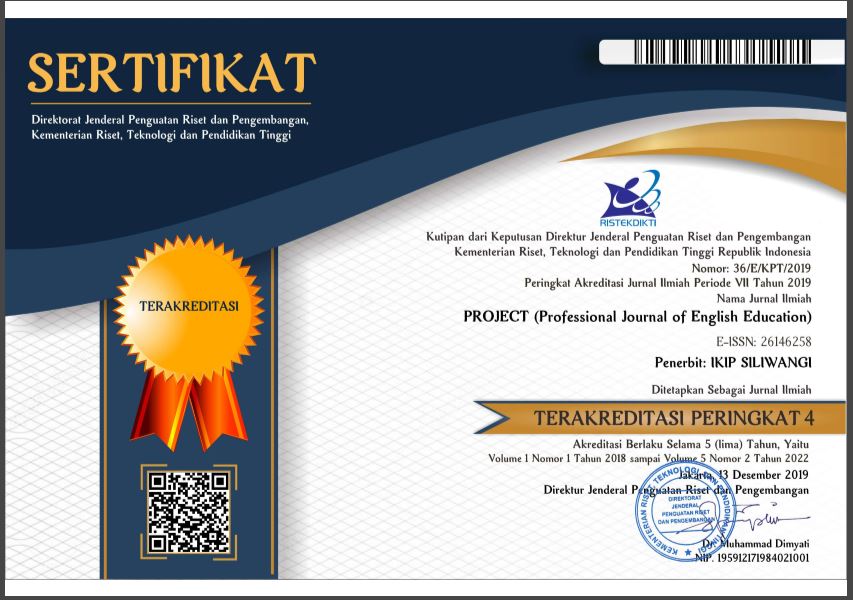INTERACTIVE COMPENSATORY MODEL: BASIS FOR THE DEVELOPMENT OF AN INTERACTIVE SUPPLEMENTARY READING MATERIAL FOR GRADE 7 LEARNERS
Abstrak
In the classroom, students had difficulties understanding the text's meaning and were unable to respond to questions. The reading process in this case was influenced by the teaching method and the lack of media. For a long time, the school's applied learning systems just gave the students access to materials and textbooks. Teachers need a learning model that will enable them to investigate the student's reading proficiency. In this particular case, the researcher tries to propose a solution by using the interactive compensatory model to propose interesting reading material. This model is the basis for creating reading learning instruments, specifically to improve reading comprehension. This model is the basis for creating reading learning instruments, specifically to improve reading comprehension. This research is development research. The type of data used in this study is a qualitative data. The data collection techniques and instruments used in this study are questionnaire and interviews. The result of this study is the eBook supplementary reading material for class 7 was rated as very good by English teacher and based on student responses and assessments.
Referensi
Agung, L & Suryani, N. (2012). Strategi Belajar Mengajar. Yogyakarta: Ombak.
Amalia, F. & Kustijono, R. (2017). Efektifitas Penggunaan E-Book Dengan Sigil Untuk Melatihkan Kemampuan Berfikir Kritis. Seminar Nasional Fisika (SNF). 81-85.
Asyhar, Rayandra. Kreatif Mengembangkan Media Pembelajaran. Jakarta: Gaung Persada Press. 2011.
Baruroh, I. & Bonita, A. (2022). English E-Book as Supporting Learning Media for X Grade Students. APPLICATION: Applied Science in Learning Research. 2. 35-42.
Baruroh, I. & Sunniyah, I. (2021). Developing English Digital Book as Learning Media for XI Grade Students. Journal of Education and Management Studies. 4. 37-44.
Benedikt, C. & Osborne, M. A. (2017). The Future of Employment: How Susceptible are Jobs to Computerisation. Technological Forecasting & Social Change. 114. 254-280.
Chastain, Kenneth. (1988). Developing Second-Language Skills Theory and Practice. Orlando: Harcourt Brace Jovanovich.
Choo, B. & Syazana, N. (2018). The Use of E-book to Improve Reading Comprehension among Year 4 Pupils. Journal of English Education. 3. 24-32.
Dalman, H. (2013). Keterampilan Membaca. Jakarta: Rajawali Press.
Ediger, Anne. (2001). Teaching Children Literacy Skills in a Second Language. In Marriene Celce Murcia (editor). teaching English as a Foreign Language. Boston: Heinle & Heinle.
Ekawati, dian. (2012). The Interactive-Compensatory Model. A Dissertation of Univeritas Pendidikan Indonesia.
Gagne, R. M. & Briggs, L. J. (1974). Principles of Instructional Design. Harcourt Brace College Publisher.
Gibbon, Pauline (2002). Scaffolding Language, Scaffolding Learning: Teaching Second Language in Mainstream Class. Portsmouth, NY: Heinemann.
Hsieh, Y. & Huang S. (2019). Using an E-book in the Secondary English Classroom: Effect on EFL Reading and Listening. Education and Information Technologies.
Hirschi, A. (2018). The Fourth Industrial Revolution: Issues and Implications for Career Research and Practice. The Career Development Quarterly. 66. 192-204.
Junaedi, D. (2019). Desain Pembelajaran Model ADDIE. 1-14.
Kemp, Jeprrold E., Smellie, Don C. Planning, Producing, and Using Instructional Media. New York: Harper & Row Publishers. 1989. 45-55.
Kurniawan, Heru. (2015). Pembelajaran Kreatif Bahasa Indonesia Kurikulum 2013. Jakarta Kencana. 70.
Lestari, R., Pranomo, A., & Soepriyanto, Y. (2018). E-Book Interaktif. Jurnal Kajian Teknologi Pendidikan. 1. 71-75.
Ma’arif, I. B., & Putri, A. B. (2022). English E-Book as Supporting Learning Media for X Grade Students. Applied science in Learning Research. 35-42.
Mahendra, A., et al. (2019). Pengembangan Lembar Kerja Peserta Didik Berbasis Problem Based Learning Untuk Meningkatkan Kemampuan Penalaran Matematika. 2. 143.
Masykur, R., Nofrizal, & Muhammad S. (2017). Pengembangan Media Pembelajaran Matematika dengan Micromedia Flash. Al-Jabar: Jurnal Pendidikan Matematika. 179.
Nieven, N. (1999). Prototyping to Reach Product Quality. London: Kluwer Academic Publisher.
Olson, J. and Diller, M. (1982). Learning to Teach Reading in Elementary School. London: Macmillan Publishing Company.
Pahrudin, A., et al. (2018). Learning Content of Islamic Education Based on Multicultural in Senior High School in Bandar Lampung. Jurnal Pendidikan Agama Islam. 9. 1
Pratidhina, E. (2020). Education 4.0: Pergeseran Pendidikan Sebagai Konsekuensi Revolusi Industri 4.0. HUMANIKA. 20. 1-12.
Pribadi, Benny A. Model Assure Untuk Mendesain Pembelajaran Sukses. Jakarta: Dian Rakyat. 2011.
Santosa, H. S., Putra, M. A. M., Banjar, D. A. O., & Permana, A. P. A. (2020). Developing English Learning Media Virtual Reality-Based for Teaching Young Learners in EFL Context. Indonesia Technology Enhanced Language Learning.
Seruni, R., et al. (2020). Implementation of e-module Flip PDF Professional to Improve Students’ Critical Thinking Skills Through Problem Based Learning. Journal of Physics: Conference Series. 1-5.
Setyaningsih, A. (2013). The Use of Three Phases Technique to Improve Students’ Participation and Reading Comprehension in Narative Text. Journal of English Language Teaching. 1-8.
Snow, C. (2002). Reading for understanding: toward an R&D Program in reading comprehension. Santa Monica, CA: Rand Corporation.
Sugiyono. (2013). Metode Penelitian Kuantitatif, Kualitatif, dan R&D. Bandung: Penerbit Alfabet.
Van Prooyen, Nancy & Clouse, R Willburn. (1984). Three Approaches to Teaching Reading: Basal, Language Experience and Computer Assisted Instruction: Nashville: ERIC
Wallace, Chatherine. (1992). Reading. Oxford: Oxford University Press.
Yusof, N. & Nubli, M. (2017). Developing medules of Spiritual Body Oriented Psychotherapy (S-BOP) to Enhance Human Potential. International Journal of Humanities Technology and Civilization. 2. 73-82.





